MULCH, SOMETIMES BETTER LATE THAN EARLY
/2 Comments/in Flowers, Fruit, Gardening, Soil, Vegetables/by Lee ReichCardoon Gets to Stay
I haven’t yet given up on cardoon — growing it. But eating it? I just about give up. It’s like eating humongous stalks of stringy celery having just a hint of artichoke flavor.
As an ornamental is how cardoon has made itself garden-worthy. Like most perennial plants, it grew only leaves this past season, its first season here. But what leaves they were! As I said, like “humongous stalks of celery.” Not much good for eating but nice to look at. The edges of the three-foot-high stalks were winged with undulating, pointed blades (each stalk is a leaf), and the whole plant is a very Mediterranean-looking olive-green.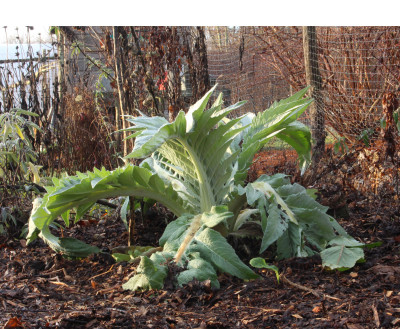
If all goes well, next year should provide an even better show, when flowers also appear. Cardoon is in the thistle family. It’s as if you injected our common (Canadian) thistle with steroids. In addition to those giant leaves, the flower stalks rise to 6 feet and are then topped by fat, spiky, cerulean balls, each a couple of inches across.
Cardoon not only looks Mediterranean; it is Mediterranean. As such, is not cold hardy this far north. Temperatures in the 20s do no harm to the top of the plant, but the top will die back when temperatures turn colder. The crown of the plant and the roots, shielded in the ground, tolerate even lower air temperatures. Eventually, though, our winter cold penetrates the ground to do them in.
But not if I soften that cold affront. Once temperatures turn colder, and stay reliably so, I’m going to lop back the tops of the plants, then pile on a thick layer of mulch, from a couple of large bags of leaves I stockpiled back in November. The reason to hold off until the soil turns colder is because in still-warm soil, the crown would have pushed out new growth beneath the mulch. That new growth would have died from lack of sun, or rotted.
Cardoon’s fleshy crown is especially prone to rotting, so I’ll lay a flat piece of plastic over the pile of mulch. That should shed rainwater while allowing some breathing room from the side.
Perhaps next year I’ll get to enjoy the flowers. Perhaps the stalks will be worth eating.
I Put The “Straw” In (On) Strawberry
Cardoon isn’t the only herbaceous perennial that needs protection from cold. Another is strawberry.
The crown of a strawberry plant is, in essence, a stem that has been telescoped down. Instead of a few inches from leaf to leaf along the stem, only a fraction of an inch separates a leaf from its next higher or lower neighbor. So instead of elongating a foot or two every year, like most stems, a strawberry crown elongates only a fraction of an inch each year.
Still, over time, that crown rises higher and higher up out of the ground, each year becoming more exposed to cold. Mulching prevents cold damage to strawberry in the same way as it does for cardoon. As with cardoon, the time to cover the plants is AFTER cold has penetrated the ground. When the soil has frozen about an inch deep is about the right time.
Strawberry crowns are not particularly prone to rotting, so there’s no need to lay a water shedding cover over the mulch. Or to cut back the leaves; strawberry leaves aren’t fleshy and don’t rise high above the ground.
Doin’ Some Dustin’
In addition to leafy mulches, already spread beneath other trees and shrubs, one other sign of creeping cold is the gray dust that has settled on parts of the meadow, beneath the pear trees, and around the currant bushes. There’s more to come, and it’s not snow. It’s ash, from the wood stove.
 Wood ash is both a waste product and a resource, depending on how much you have and how much space you have to spread it. As a resource, it’s high in potassium, an essential nutrient for plants, and contains other essential elements. Wood ash decreases the acidity of soils which, around here, mostly increases naturally over time.
Wood ash is both a waste product and a resource, depending on how much you have and how much space you have to spread it. As a resource, it’s high in potassium, an essential nutrient for plants, and contains other essential elements. Wood ash decreases the acidity of soils which, around here, mostly increases naturally over time.
But too much potassium can be a bad thing. As can too little acidity; slightly acid soil is what’s ideal for most plants.
Since wood ash varies somewhat in its composition, it’s impossible to put a number on how much to spread. No more than 20 pounds per thousand square feet is reasonable, except on alkaline soils (pH greater than 7) or beneath acid-loving plants such as blueberry, azalea, and rhododendron, which should get none. I disperse it over the whole farmden — on the meadow and the lawn, beneath fruit and nut trees and bushes — to avoid concentrating it anywhere. I also save some to spread on icy walks and to sprinkle around plants if slugs become a problem.
THE CHILL BANK IS FILLED?
/0 Comments/in Flowers, Fruit, Gardening, Houseplants, Planning/by Lee ReichBut Do I Want Flowers Now?
The season has been “chill,” literally and figuratively, the former predicted by weather experts based on a this year’s strong El Niño.
Because of El Niño, the West was pounded with rain; here in the Northeast, except for an occasional night, temperatures have been mild over the past few months, much milder than I remember for any other fall. It is those chilly, but not frigid, temperatures — in the range from 30 to 45 degrees Fahrenheit — that signal to plants that winter is over and it’s safe to begin unfolding flower buds or pushing new shoots from dormant buds. A certain number of hours within this temperature range does the trick, typically about a thousand hours, the exact requirements varying from plant to plant. Temperatures below 30 or above 45 degrees don’t contribute to the needed hours, can even set the clock back and increase the number of hours still needed.
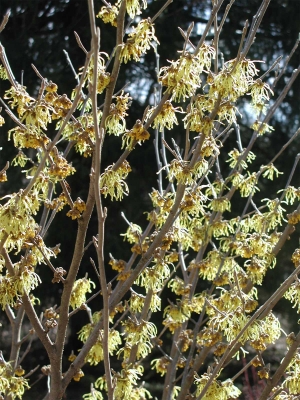
Witchhazel blooming in autumn
Typically, in the Northeast, required chilling hours are not fulfilled in autumn. Some are, but then temperatures typically plummet. The “chilling bank” is finally topped up in late winter or early spring. Growth then only awaits favorable growing conditions, which mostly means sufficiently warm temperatures.
This fall, however, some or all chilling hours have been fulfilled — not a good thing, for humans. Flowers on fruit trees and bushes will probably unfold earlier than usual, at time when they are then threatened by subsequent frosts that could wipe out next season’s harvest. Ornamentals also will probably flower earlier — no big deal if all we want from them is flowers. My Arnold’s Promise witchhazel usually flowers in March. This year’s October flowering means no flowers this coming spring.
Buds that grow into shoots will also awaken earlier next year. Shoots begin growth after the earliest flowers so aren’t as threatened by subsequent cold snaps. Even if they get burned by frost, they usually just push out new stems from undamaged buds that otherwise might have remained dormant for the season.
Native Fruits Fare Better
One plus for growing native plants is that they are more adapted to the vagaries of our climate than non-natives. Apricots, for instance, present a challenge because they need relatively few hours of chilling to awaken. They are one of the first trees to bloom.
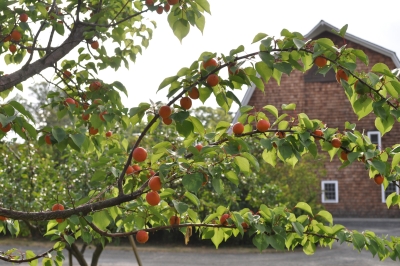
Apricots after a good winter & spring
Low chilling requirement is no problem in apricots’ native haunts, where winters are cold but springs warm steadily. Around here, though, wild temperature fluctuations in winter and spring fulfill chilling requirements early; blossoms appear so early that they’re almost sure to be nipped out by subsequent drops in temperature. A warm fall gets the flower buds ready for opening even earlier.
I am more optimistic about my American persimmons, pawpaws, highbush and lowbush blueberries, and grapes for next year. These natives are accustomed to our variable temperatures, so rarely fail. Perhaps they won’t fail even after this wacky fall weather.
Plants Chillin’ Indoors
Just chillin’, figuratively, are houseplants. As tropical and subtropical plants, they can remain somewhat aloof to the weather, except to grow when the weather is warm, and “chill out” — that is, just sit still — when temperatures cool. “Warm” and “cool,” in this case, span a narrow range, either outdoors in summer or indoors in winter.
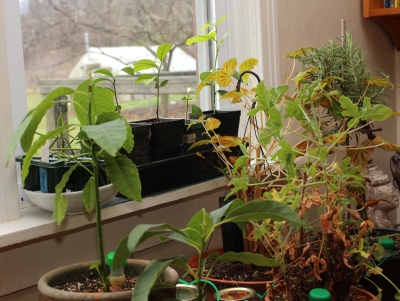
Windowsill fruits- avocado, Rhpsalis, lemon
Still, sunlight and perhaps other subtle, seasonal changes in houseplants’ sheltered environment have their effects. So right now, houseplants mostly just “chill out.” I’m drumming my fingers, waiting. All these plants need now is water, when thirsty.
Once we get over the hump (trough?) of the shortest day and light becomes stronger and longer, houseplants will perk up and begin growing. Then, they might need some fertilizer, commensurate with growth, in addition to water.
Right now, I’m awaiting blossoms from Odontoglossum pulchellum (that’s an orchid, no common name), blossoms and fruit set from Meyer lemon and Golden Nugget mandarin, and fruits to finish ripening on Meiwa kumquat and Abraco olive.
OTHER APPROACHES TO SUSTAINABLE VEGETABLES
/5 Comments/in Fruit, Gardening, Soil, Vegetables/by Lee Reich“Grass-fed Vegetables”
With gardening activities grinding almost to a halt, I can take a breath and reflect on the past season — one of the best seasons ever. Of course, I’ll “blame” the bountifulness mostly on the weather. Maybe I’m also becoming a better gardener. (Thomas Jefferson wrote, “Though an old man, I am a young gardener.”)
I wrote a couple of weeks ago about soil management here on the farmden. It’s simple and possibly sustainable. For the vegetable gardens: no digging, permanent beds, and an inch depth of homemade compost annually slathered onto those beds. For trees and shrubs, mulches of compost, wood chips or leaves, supplemented, if necessary, with soybean or alfalfa meal for additional nitrogen.
My September trip to Maine afforded me two other perspectives on soil management. The first came from a presentation by, and conversation with, Jim Kovaleski, who farms in northern Maine. His system is also simple and possibly sustainable. His farm has 5 acres of hayfield that feeds 1/2 acre of vegetables. “Grass-fed vegetables,” as he calls it. All he does is scythe the hayfield portions and pile the mowings onto the growing areas, in so doing suppressing weeds, locking moisture within the soil, and feeding the ground with the decomposing hay.
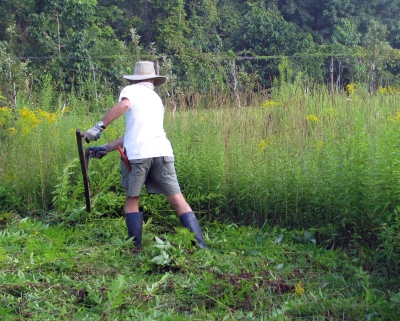
Me, scything my field
The question is whether or not the mowed portions can naturally regenerate nutrients through dissolution of native minerals and nitrogen fixation by microbes to keep up with the removal of mowings. Possibly, some essential micronutrient might be missing from that particular piece of ground. To avoid that possibility here on my farmden, I feed my compost a diversity of organic materials, from old Levi’s to orange peels, from Florida oranges, to neighbor’s autumn leaves, and, just to make further sure, kelp.
I didn’t get to visit Jim’s farm, but did hear first-hand testimonials praising the quality and yield of his vegetables.
Come fall, Jim moves his show south, with repeat performances at his mini-farm in suburban Florida, there using yard waste compost and seaweed he harvests to build and maintain soil health, sustainably.
Chicken-fed(?) Vegetables
I did get to visit Four Season Farm, the Maine farm of vegetable guru Elliot Coleman. His system is to grow vegetables for a season, then till the ground and sow grass and clover, graze chickens on that piece of land for a season before tilling it again to grow vegetables. The chickens’ diet is supplemented with bought grain. The bought grain reduces the system’s “sustainability quotient.” On the other hand, as Elliot emphatically pointed out, he is also growing chickens!
The bought grain reduces the system’s “sustainability quotient.” On the other hand, as Elliot emphatically pointed out, he is also growing chickens!
It would be interesting to measure all the inputs and outputs from my soil management, as well as those of Jim and Elliot. And also to quantify any trends in measures of soil health (nutrients, organic matter, soil tilth, etc.) and quality of vegetables.
A Fruitful Year, Literally!
As I drove the highways and byways of Maine, I was astounded at the number of wild, roadside apple trees, and their fruits’ freedom from pests. First, why so many wild trees? Does everyone there munch on apples while driving, then toss the cores out their windows? Why are there so few wild trees here in the Hudson Valley, a major apple-growing region?
And second, why so few pest blemishes on the fruits? In the Northeast — nay, the whole eastern part of the country — pests generally run rampant on apples. Then again, apples have done relatively well, pest- and otherwise this season here in the Hudson Valley also.
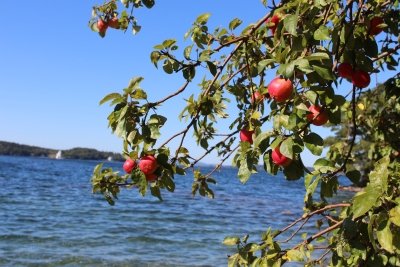
Maine’s wild apples
For that matter, it’s generally been an excellent season for all fruits. Even black walnuts, whose nuts haven’t filled out for the past few years (a legacy from hurricane Irene and tropical storm Lee?) bore abundant crops fat with nutmeats this year.
I had only one failure this year, pawpaws, and it was the first crop failure in decades. Why the poor showing? Again, I’ll blame it on the weather. But what about the weather could be to blame?

